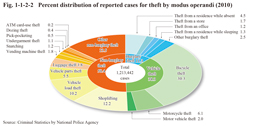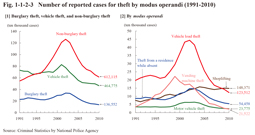Section 2 Non-traffic Penal Code Offenses
1 Theft
Theft accounted for 76.5% of reported cases for non-traffic penal code offenses in 2010. Fig. 1-1-2-1 shows the number of reported cases, number of cleared cases, and clearance rate for theft over the last 30 years. The number of reported cases for theft increased whereas the clearance rate declined from 1995 through to 2001. However, the clearance rate then started to rise again in 2002, whereas the number of reported cases started to decrease in 2003, thus putting the brake on a worsening situation. The number of reported cases turned to a decreasing trend after reaching a post WWII high level of 2,377,488 in 2002 and then subsequently continued to decrease every year from 2003. In 2010 it was 1,213,442, a decrease of 1,164,046 (49.0%) from 2002. In 2010 the number of cleared cases was 327,786 (down 34,183 or 9.4% from the previous year) and the number of persons cleared 175,214 (down 609 or 0.3% (id.)). The clearance rate, however, continued to rise every year from 2002 through to 2009 (27.9%), although it declined by 0.8 points from the previous year to 27.0% in 2010, but which was still 11.3 points higher than the post WWII low level of 2001.
Fig. 1-1-2-1 Number of reported/cleared cases and clearance rate for theft (1981-2010)
Fig. 1-1-2-2 shows the percent distribution of reported cases for theft by modus operandi in 2010. By type of theft, non-burglary theft accounted for over 50%. By modus operandi, bicycle theft, shoplifting, and vehicle load theft accounted for the highest proportions in that order (See the Appendix for the number of reported cases by modus operandi).
Fig. 1-1-2-2 Percent distribution of reported cases for theft by modus operandi (2010)
Fig. 1-1-2-3 [1] shows the number of reported cases for burglary theft, vehicle theft, and non-burglary theft over the last 20 years. With all types of theft the number of reported cases was decreasing after reaching a peak in around 2001-2002. Fig. 1-1-2-3 [2] shows the number of reported cases for some of the modus operandi over the last 20 years. The number of reported cases for vending machine theft significantly decreased after reaching a peak in 1999 (approximately 220 thousand cases, accounting for 11.6% of all theft cases). That for shoplifting continued to increase until 2004 and subsequently remained stable.
Fig. 1-1-2-3 Number of reported cases for theft by modus operandi (1991-2010)


